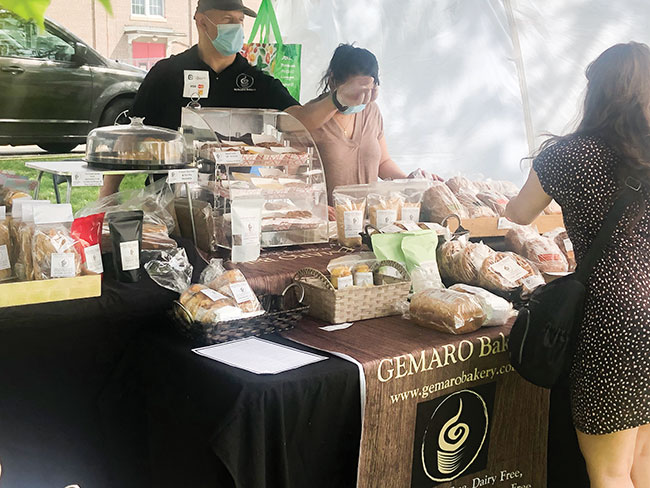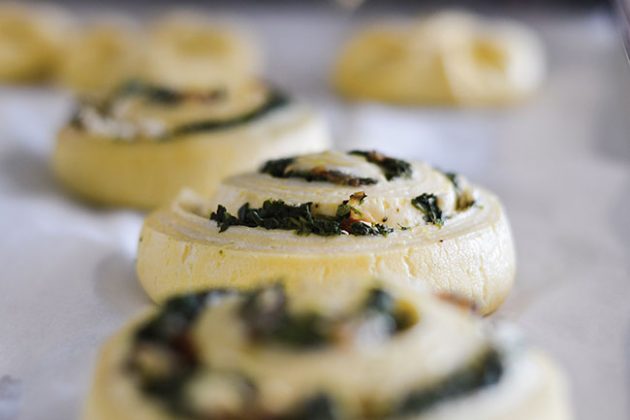
Takeout survival tips
June 23, 2021
By Dominic Messier
Adding accessibility to your business
 With a short time to linger at the cash, making your cashier’s area mouthwatering can motivate your clients to make impulse purchases.
Photo credit: Dominic Messier.
With a short time to linger at the cash, making your cashier’s area mouthwatering can motivate your clients to make impulse purchases.
Photo credit: Dominic Messier. In a talk presented by SkipTheDishes, Restaurants Canada brought experts from the Fast Casual segment to talk about how incorporating or even pivoting to an all take-out model can save your business. They discussed how they transformed their operations, and your bakery can learn from their experiences, and help your operation move forward once cities open up again.
In the last year, surviving bakery-cafés, delicatessens and pizza parlours were forced to pivot their entire business model from full service to take-out and delivery. Those lucky enough to have a patio, experienced a fifty per cent capacity drop, due to social distance regulations.
Learning how to focus business operations was central, but nothing divided companies between the quick and the dead like optimization through online ordering. Companies that added their menu to third party delivery companies and promoted their menu and specialties heavily on social media saw their companies survive.
Focus on oven time and staff
Alan Bekerman, Founder and CEO of iQ Food Co, said, “March 15 of last year, I think we were all kind of staring into the abyss and had no idea what was in store. We laid off 95 per cent of our staff, because we were closing all of our restaurants. Today, we’re back with about 60-65 per cent. “Certainly, limiting hours at certain restaurants and we’re being a lot more mindful. Pre-pandemic, we had freedom to operate with more ‘looseness’ around “slower times,” now you have to be laser focused about when it makes sense to be open and when it doesn’t, and simplify your menus.”
Clean, easy-to-use websites for ordering
Having a website that features clear, well-lit photos of food with sharp edges and clearly defined features that can pick out the details of texture really help make a potential client’s mouth water, prompting them to order.
Scott Boatwright, Chief Restaurant Officer, of Chipotle adds, “I think most brands who have invested [in digital platforms] are going to fare well, and those who haven’t need to figure out their path forward as it relates to digital and, and then figure out what’s the right economic model, or find out what can their economic model sustain as it relates to delivery, because we all know that can be expensive.”
Boatright adds that it’s really centered around the idea of access. Bruce Miller, President, The WORKS Craft Burgers & Beer, South St Burger, Big Smoke Burger & Tosto Quickfire Pizza & Pasta, agrees. Miller says, “the layouts on the app is very important that it’s intuitive for our guests. Next is to ensure on the operation side that it’s as seamless as possible, so we’re one of the first in Canada to fully integrated in Skip The Dishes into our POS systems. So, we were able to be able to skip that input step, which was avoiding have a ton of errors as well as an addition of time.

An attractive and navigatable website contributed to Best Kind Bakery’s success.
Photo credit: Best Kind Bakery.
Travel-safe packaging
If placing an order is key, ensuring that the packaging is sound but appealing is the next step. Once the delivery is made, a customer would like to know that food is still warm (or cold) and either easy to assemble, or requires no “fixing” to make it palatable. Miller feels that a successful food delivery model is one where the customer doesn’t feel they are ordering take out.
Miller adds, “We’ve really focused and relaunched a whole bunch of our packaging, to make sure that it contains the heat well…. so when it shows up on your doorstep at home, that is as close as it can get in terms of that in dining experience.”
Your online ‘food story’ can be about people
Getting your customer’s attention is the largest part of the equation. Beckerman adds that sharing your café or bakery’s story isn’t limited to food: “The stories that we tell on social media are now about the food, and more so the profiles of the people that are actually crafting the food. So, really just doing little things like that…those small, magic moments that our customers traditionally had in our restaurants.” Beckerman suggests posting in a way that “bridges the gap” between customer and client. The best way to reach out during and after a delivery is a surprisingly personal touch.
“Handwritten notes or notes thank you notes. Just something as small as a person’s name on a takeaway bag, and a little smile,” explains Beckerman. “I mean, I get that from my local takeout spot, it’s little things like that that that really kind of communicate that folks care.”
Bang for the buck
Keeping an eye on food trends and consumption preferences was another way to tap in to consumers’ mind set. Beckerman recalls the early days of the pandemic. “Our offering traditionally has been kind of on that individual office worker who’s grabbing lunch for themselves, and headed back to their to their desk. So, with most folks working from home now, the shift that we’ve seen is people aren’t really so interested in single meals that satisfy only that one time. They want things that will perhaps stretch over multiple meals, or feed more than one person in their house.”
“We asked, ‘can we take what we do and showcase the products that we’re serving in our restaurants, but do it in a way that’s a little bit more befitting of the experience at home?’And these are not one-off, $15 and $16 grain bowls or salads that they might get at our restaurants, but $45 to $70 meal that serves two to four people that they’re cooking in their homes themselves.”
Beckerman’s view of providing a dining-out experience for those dining in means that the quality of the food must remain exactly the same as it was for pre-COVID dining. Boatright agrees, “I think the food has to speak for itself, and Bruce and Alan both talked about this as well. It’s got to be a great experience. it’s got to be what I’m traditionally used to…I think it’s got to be uniquely yours, it’s got to be a great experience. Otherwise you’ll just miss the mark, and you lose the, you lose frequency from your consumers.”
Print this page
Leave a Reply